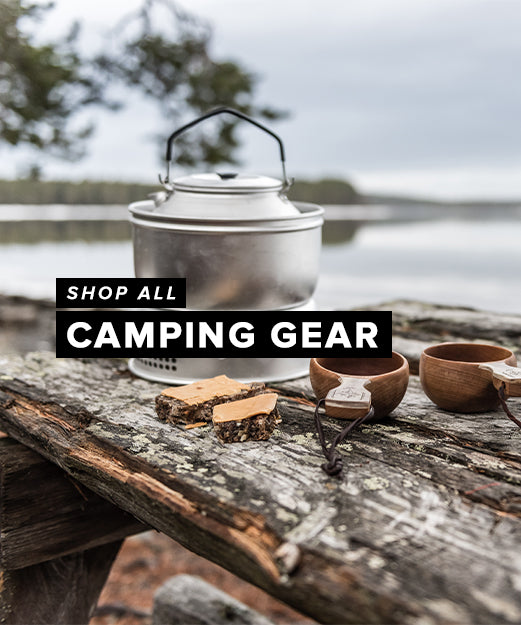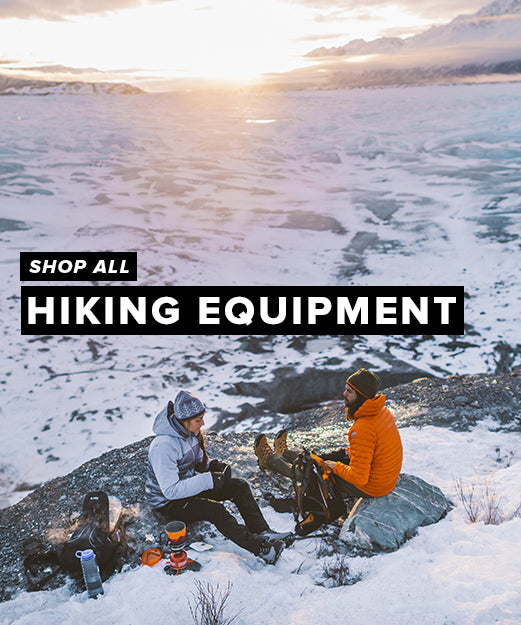 The first piece of advice on how to make it safely through a whiteout begins long before you have even started your hike or climb. Always dress appropriately for the worst possible scenario and carry emergency supplies. Even on a relatively easy and short hike one can fall prey to an emergency, sudden storm or accident, so it is best to always be fully prepared.
Some must-have items for your hiking or climbing pack include a small but comprehensive first aid kit, some yellow lensed glasses (these can cut the dazzle and glare from the whiteout, allowing you to make out more details) and a paper map, with your planned trail clearly marked. The map can be accompanied by an electronic GPS, but should never be forgotten. If you fall you may break the GPS which then makes the map doubly important to your survival. The map should be enclosed in a sturdy see-through plastic bag to keep it dry and protected.
If, as you are climbing or hiking, you happen to realise that conditions are worsening and suspect that a whiteout may be imminent, immediately turn and retrace your steps as fast as is prudent. Aim to get back to safety before the storm hits, or to at least make it to a safe way-station where you can sit out the worst of the storm in relative comfort.
If the storm is upon you with no warning and you find yourself in the middle of a whiteout before you realise what is happening, stay calm. If it is safe to do so, rig your emergency shelter and hunker down to wait out the storm – it may clear quickly, allowing you to continue safely on your way. It is important to force yourself to stay calm and still as our natures often impel us to move to a safer place. This is often a poor impulse, especially in rocky areas full of crevices, holes and sheer drops – it is all too easy to stumble and fall with potentially lethal consequences.
However, sometimes it is not possible to stay where you are. If the whiteout conditions persist for many hours, you may be forced to move after all. If you have to move, do so deliberately and carefully, making sure you are oriented as to your direction and looking as far ahead as possible for any signs of sudden drops or gaps in the path. If possible throw a brightly coloured line, series of snow balls or even tree boughs ahead of you. These will alert your to changes in the incline and warn you of any possible dangers before you find them the hard way! Try to descend at least as far as the tree line as this will give you some protection from the storm and give you some perspective in what you are seeing.
Never separate from your companions while in a whiteout. In a shockingly short time you will lose track of each other and potentially wander far from the path in search of each other. Make sure that you keep all the other hikers or climbers in sight at all times and stay in contact by shouting out to each other when it is safe to do so.
Every climber and hiker who goes off the beaten track should know how to dead reckon, just in case of emergencies like this. If you can work out your speed and direction (using that paper map mentioned above!) and know the point from which you started, you will be able to work out where you are, and therefore how to get safely back home again!
Being caught in a whiteout is a scary and nerve-wracking experience sure to shake the confidence and skills of even the most adept climber or hiker. However, being able to survive such an occurrence, returning safely home to your loved ones is a thrill and ego boost that money cannot buy. Prepare for and expect the worst on every hike or climb. It is infinitely better to have the knowledge and skills that will see you surviving a potentially life-threatening event and never to use them, than to not have them and die for that want…
Have you experienced a Whiteout? What was it like and what did you do? Please tell us below!
The first piece of advice on how to make it safely through a whiteout begins long before you have even started your hike or climb. Always dress appropriately for the worst possible scenario and carry emergency supplies. Even on a relatively easy and short hike one can fall prey to an emergency, sudden storm or accident, so it is best to always be fully prepared.
Some must-have items for your hiking or climbing pack include a small but comprehensive first aid kit, some yellow lensed glasses (these can cut the dazzle and glare from the whiteout, allowing you to make out more details) and a paper map, with your planned trail clearly marked. The map can be accompanied by an electronic GPS, but should never be forgotten. If you fall you may break the GPS which then makes the map doubly important to your survival. The map should be enclosed in a sturdy see-through plastic bag to keep it dry and protected.
If, as you are climbing or hiking, you happen to realise that conditions are worsening and suspect that a whiteout may be imminent, immediately turn and retrace your steps as fast as is prudent. Aim to get back to safety before the storm hits, or to at least make it to a safe way-station where you can sit out the worst of the storm in relative comfort.
If the storm is upon you with no warning and you find yourself in the middle of a whiteout before you realise what is happening, stay calm. If it is safe to do so, rig your emergency shelter and hunker down to wait out the storm – it may clear quickly, allowing you to continue safely on your way. It is important to force yourself to stay calm and still as our natures often impel us to move to a safer place. This is often a poor impulse, especially in rocky areas full of crevices, holes and sheer drops – it is all too easy to stumble and fall with potentially lethal consequences.
However, sometimes it is not possible to stay where you are. If the whiteout conditions persist for many hours, you may be forced to move after all. If you have to move, do so deliberately and carefully, making sure you are oriented as to your direction and looking as far ahead as possible for any signs of sudden drops or gaps in the path. If possible throw a brightly coloured line, series of snow balls or even tree boughs ahead of you. These will alert your to changes in the incline and warn you of any possible dangers before you find them the hard way! Try to descend at least as far as the tree line as this will give you some protection from the storm and give you some perspective in what you are seeing.
Never separate from your companions while in a whiteout. In a shockingly short time you will lose track of each other and potentially wander far from the path in search of each other. Make sure that you keep all the other hikers or climbers in sight at all times and stay in contact by shouting out to each other when it is safe to do so.
Every climber and hiker who goes off the beaten track should know how to dead reckon, just in case of emergencies like this. If you can work out your speed and direction (using that paper map mentioned above!) and know the point from which you started, you will be able to work out where you are, and therefore how to get safely back home again!
Being caught in a whiteout is a scary and nerve-wracking experience sure to shake the confidence and skills of even the most adept climber or hiker. However, being able to survive such an occurrence, returning safely home to your loved ones is a thrill and ego boost that money cannot buy. Prepare for and expect the worst on every hike or climb. It is infinitely better to have the knowledge and skills that will see you surviving a potentially life-threatening event and never to use them, than to not have them and die for that want…
Have you experienced a Whiteout? What was it like and what did you do? Please tell us below!
How to Survive a Whiteout
Hiking and mountain climbing are excellent activities for those with a sporty, athletic and adventurous disposition. The joy of pushing your body to make just another mile or to summit just one more peak is all but indescribable to lounge lizards, huddled inside around the television. However, as with all daring pursuits there are dangers out in the open and it is best to be prepared for the bad as well as the good.
A whiteout occurs when a snow storm (or sand storm, in desert regions) blows up with little or no warning. Visibility is reduced to mere feet and it is shocking how quickly hikers and climbers can lose track of where they are going and even which way is up or down. With no visible markers to guide you and just blinding white all around you it is easy to become disoriented and panic, completely forgetting all your safety training.
 The first piece of advice on how to make it safely through a whiteout begins long before you have even started your hike or climb. Always dress appropriately for the worst possible scenario and carry emergency supplies. Even on a relatively easy and short hike one can fall prey to an emergency, sudden storm or accident, so it is best to always be fully prepared.
Some must-have items for your hiking or climbing pack include a small but comprehensive first aid kit, some yellow lensed glasses (these can cut the dazzle and glare from the whiteout, allowing you to make out more details) and a paper map, with your planned trail clearly marked. The map can be accompanied by an electronic GPS, but should never be forgotten. If you fall you may break the GPS which then makes the map doubly important to your survival. The map should be enclosed in a sturdy see-through plastic bag to keep it dry and protected.
If, as you are climbing or hiking, you happen to realise that conditions are worsening and suspect that a whiteout may be imminent, immediately turn and retrace your steps as fast as is prudent. Aim to get back to safety before the storm hits, or to at least make it to a safe way-station where you can sit out the worst of the storm in relative comfort.
If the storm is upon you with no warning and you find yourself in the middle of a whiteout before you realise what is happening, stay calm. If it is safe to do so, rig your emergency shelter and hunker down to wait out the storm – it may clear quickly, allowing you to continue safely on your way. It is important to force yourself to stay calm and still as our natures often impel us to move to a safer place. This is often a poor impulse, especially in rocky areas full of crevices, holes and sheer drops – it is all too easy to stumble and fall with potentially lethal consequences.
However, sometimes it is not possible to stay where you are. If the whiteout conditions persist for many hours, you may be forced to move after all. If you have to move, do so deliberately and carefully, making sure you are oriented as to your direction and looking as far ahead as possible for any signs of sudden drops or gaps in the path. If possible throw a brightly coloured line, series of snow balls or even tree boughs ahead of you. These will alert your to changes in the incline and warn you of any possible dangers before you find them the hard way! Try to descend at least as far as the tree line as this will give you some protection from the storm and give you some perspective in what you are seeing.
Never separate from your companions while in a whiteout. In a shockingly short time you will lose track of each other and potentially wander far from the path in search of each other. Make sure that you keep all the other hikers or climbers in sight at all times and stay in contact by shouting out to each other when it is safe to do so.
Every climber and hiker who goes off the beaten track should know how to dead reckon, just in case of emergencies like this. If you can work out your speed and direction (using that paper map mentioned above!) and know the point from which you started, you will be able to work out where you are, and therefore how to get safely back home again!
Being caught in a whiteout is a scary and nerve-wracking experience sure to shake the confidence and skills of even the most adept climber or hiker. However, being able to survive such an occurrence, returning safely home to your loved ones is a thrill and ego boost that money cannot buy. Prepare for and expect the worst on every hike or climb. It is infinitely better to have the knowledge and skills that will see you surviving a potentially life-threatening event and never to use them, than to not have them and die for that want…
Have you experienced a Whiteout? What was it like and what did you do? Please tell us below!
The first piece of advice on how to make it safely through a whiteout begins long before you have even started your hike or climb. Always dress appropriately for the worst possible scenario and carry emergency supplies. Even on a relatively easy and short hike one can fall prey to an emergency, sudden storm or accident, so it is best to always be fully prepared.
Some must-have items for your hiking or climbing pack include a small but comprehensive first aid kit, some yellow lensed glasses (these can cut the dazzle and glare from the whiteout, allowing you to make out more details) and a paper map, with your planned trail clearly marked. The map can be accompanied by an electronic GPS, but should never be forgotten. If you fall you may break the GPS which then makes the map doubly important to your survival. The map should be enclosed in a sturdy see-through plastic bag to keep it dry and protected.
If, as you are climbing or hiking, you happen to realise that conditions are worsening and suspect that a whiteout may be imminent, immediately turn and retrace your steps as fast as is prudent. Aim to get back to safety before the storm hits, or to at least make it to a safe way-station where you can sit out the worst of the storm in relative comfort.
If the storm is upon you with no warning and you find yourself in the middle of a whiteout before you realise what is happening, stay calm. If it is safe to do so, rig your emergency shelter and hunker down to wait out the storm – it may clear quickly, allowing you to continue safely on your way. It is important to force yourself to stay calm and still as our natures often impel us to move to a safer place. This is often a poor impulse, especially in rocky areas full of crevices, holes and sheer drops – it is all too easy to stumble and fall with potentially lethal consequences.
However, sometimes it is not possible to stay where you are. If the whiteout conditions persist for many hours, you may be forced to move after all. If you have to move, do so deliberately and carefully, making sure you are oriented as to your direction and looking as far ahead as possible for any signs of sudden drops or gaps in the path. If possible throw a brightly coloured line, series of snow balls or even tree boughs ahead of you. These will alert your to changes in the incline and warn you of any possible dangers before you find them the hard way! Try to descend at least as far as the tree line as this will give you some protection from the storm and give you some perspective in what you are seeing.
Never separate from your companions while in a whiteout. In a shockingly short time you will lose track of each other and potentially wander far from the path in search of each other. Make sure that you keep all the other hikers or climbers in sight at all times and stay in contact by shouting out to each other when it is safe to do so.
Every climber and hiker who goes off the beaten track should know how to dead reckon, just in case of emergencies like this. If you can work out your speed and direction (using that paper map mentioned above!) and know the point from which you started, you will be able to work out where you are, and therefore how to get safely back home again!
Being caught in a whiteout is a scary and nerve-wracking experience sure to shake the confidence and skills of even the most adept climber or hiker. However, being able to survive such an occurrence, returning safely home to your loved ones is a thrill and ego boost that money cannot buy. Prepare for and expect the worst on every hike or climb. It is infinitely better to have the knowledge and skills that will see you surviving a potentially life-threatening event and never to use them, than to not have them and die for that want…
Have you experienced a Whiteout? What was it like and what did you do? Please tell us below!
 The first piece of advice on how to make it safely through a whiteout begins long before you have even started your hike or climb. Always dress appropriately for the worst possible scenario and carry emergency supplies. Even on a relatively easy and short hike one can fall prey to an emergency, sudden storm or accident, so it is best to always be fully prepared.
Some must-have items for your hiking or climbing pack include a small but comprehensive first aid kit, some yellow lensed glasses (these can cut the dazzle and glare from the whiteout, allowing you to make out more details) and a paper map, with your planned trail clearly marked. The map can be accompanied by an electronic GPS, but should never be forgotten. If you fall you may break the GPS which then makes the map doubly important to your survival. The map should be enclosed in a sturdy see-through plastic bag to keep it dry and protected.
If, as you are climbing or hiking, you happen to realise that conditions are worsening and suspect that a whiteout may be imminent, immediately turn and retrace your steps as fast as is prudent. Aim to get back to safety before the storm hits, or to at least make it to a safe way-station where you can sit out the worst of the storm in relative comfort.
If the storm is upon you with no warning and you find yourself in the middle of a whiteout before you realise what is happening, stay calm. If it is safe to do so, rig your emergency shelter and hunker down to wait out the storm – it may clear quickly, allowing you to continue safely on your way. It is important to force yourself to stay calm and still as our natures often impel us to move to a safer place. This is often a poor impulse, especially in rocky areas full of crevices, holes and sheer drops – it is all too easy to stumble and fall with potentially lethal consequences.
However, sometimes it is not possible to stay where you are. If the whiteout conditions persist for many hours, you may be forced to move after all. If you have to move, do so deliberately and carefully, making sure you are oriented as to your direction and looking as far ahead as possible for any signs of sudden drops or gaps in the path. If possible throw a brightly coloured line, series of snow balls or even tree boughs ahead of you. These will alert your to changes in the incline and warn you of any possible dangers before you find them the hard way! Try to descend at least as far as the tree line as this will give you some protection from the storm and give you some perspective in what you are seeing.
Never separate from your companions while in a whiteout. In a shockingly short time you will lose track of each other and potentially wander far from the path in search of each other. Make sure that you keep all the other hikers or climbers in sight at all times and stay in contact by shouting out to each other when it is safe to do so.
Every climber and hiker who goes off the beaten track should know how to dead reckon, just in case of emergencies like this. If you can work out your speed and direction (using that paper map mentioned above!) and know the point from which you started, you will be able to work out where you are, and therefore how to get safely back home again!
Being caught in a whiteout is a scary and nerve-wracking experience sure to shake the confidence and skills of even the most adept climber or hiker. However, being able to survive such an occurrence, returning safely home to your loved ones is a thrill and ego boost that money cannot buy. Prepare for and expect the worst on every hike or climb. It is infinitely better to have the knowledge and skills that will see you surviving a potentially life-threatening event and never to use them, than to not have them and die for that want…
Have you experienced a Whiteout? What was it like and what did you do? Please tell us below!
The first piece of advice on how to make it safely through a whiteout begins long before you have even started your hike or climb. Always dress appropriately for the worst possible scenario and carry emergency supplies. Even on a relatively easy and short hike one can fall prey to an emergency, sudden storm or accident, so it is best to always be fully prepared.
Some must-have items for your hiking or climbing pack include a small but comprehensive first aid kit, some yellow lensed glasses (these can cut the dazzle and glare from the whiteout, allowing you to make out more details) and a paper map, with your planned trail clearly marked. The map can be accompanied by an electronic GPS, but should never be forgotten. If you fall you may break the GPS which then makes the map doubly important to your survival. The map should be enclosed in a sturdy see-through plastic bag to keep it dry and protected.
If, as you are climbing or hiking, you happen to realise that conditions are worsening and suspect that a whiteout may be imminent, immediately turn and retrace your steps as fast as is prudent. Aim to get back to safety before the storm hits, or to at least make it to a safe way-station where you can sit out the worst of the storm in relative comfort.
If the storm is upon you with no warning and you find yourself in the middle of a whiteout before you realise what is happening, stay calm. If it is safe to do so, rig your emergency shelter and hunker down to wait out the storm – it may clear quickly, allowing you to continue safely on your way. It is important to force yourself to stay calm and still as our natures often impel us to move to a safer place. This is often a poor impulse, especially in rocky areas full of crevices, holes and sheer drops – it is all too easy to stumble and fall with potentially lethal consequences.
However, sometimes it is not possible to stay where you are. If the whiteout conditions persist for many hours, you may be forced to move after all. If you have to move, do so deliberately and carefully, making sure you are oriented as to your direction and looking as far ahead as possible for any signs of sudden drops or gaps in the path. If possible throw a brightly coloured line, series of snow balls or even tree boughs ahead of you. These will alert your to changes in the incline and warn you of any possible dangers before you find them the hard way! Try to descend at least as far as the tree line as this will give you some protection from the storm and give you some perspective in what you are seeing.
Never separate from your companions while in a whiteout. In a shockingly short time you will lose track of each other and potentially wander far from the path in search of each other. Make sure that you keep all the other hikers or climbers in sight at all times and stay in contact by shouting out to each other when it is safe to do so.
Every climber and hiker who goes off the beaten track should know how to dead reckon, just in case of emergencies like this. If you can work out your speed and direction (using that paper map mentioned above!) and know the point from which you started, you will be able to work out where you are, and therefore how to get safely back home again!
Being caught in a whiteout is a scary and nerve-wracking experience sure to shake the confidence and skills of even the most adept climber or hiker. However, being able to survive such an occurrence, returning safely home to your loved ones is a thrill and ego boost that money cannot buy. Prepare for and expect the worst on every hike or climb. It is infinitely better to have the knowledge and skills that will see you surviving a potentially life-threatening event and never to use them, than to not have them and die for that want…
Have you experienced a Whiteout? What was it like and what did you do? Please tell us below!
 NEW!! Free UK Delivery
NEW!! Free UK Delivery Hassle-Free Returns
Hassle-Free Returns Clearpay
Clearpay









